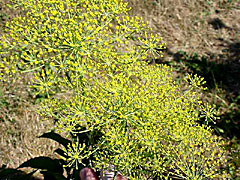


Home
Flowers &
Indoor Plants
Fruits & Nuts
Ornamentals
Vegetables
Special Topics
Resources
Glossary

|
Dill Anethum graveolens (an-ee-thum grah-vee-oh-lenz) 
 |
 |
What about it? Dill is a hardy annual, or a biennial herb, and a member of the Parsley Family. Its cousins are carrots, celery, parsnips, and fennel. It grows to a height of 2 1/2 feet from a single stalk, branching out into yellow, umbel-shaped, temrinal flowers. What is it used for? The name "dill" comes from a Norse word "dilla" that means to lull. This relates to the soothing properties of the herb and perhaps its popularity in cooking. The flowers will go to seed in midsummer and the dill seeds are used in cooking. The leaves can be harvested before the herb flowers and can be used as a seasoning as well. Where does it grow? How do we grow it? Dill needs a plot of full sun and sandy, well-drained soil. What are its primary problems? Dill is a persistent herb and does not encounter many problems. How do we propagate it? Sow seeds directly in the spring, dill doesn't transplant well. Be sure to harvest all the seed heads in the summer or they may fall to the ground and self-sow the following year. How do we harvest and store it? Harvest the dill leaves before flowering. Harvest the dill seeds when they appear after flowering. Cut heads and dry leaves. Store in a dry jar out of the sunlight.
© Copyright, Department of Horticulture, Cornell University. |